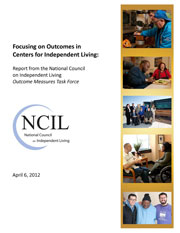Authored by: Vicki Haws and Shannon Jones, Co-Chairs, NCIL Rehabilitation Act Subcommittee
We were pleased to see the results of an audit by the U.S Department of Education’s Office of Inspector General regarding Centers for Independent Living Compliance, Performance, Recovery Act Reporting, and Monitoring. These results highlighted many of the concerns that have been voiced by Centers for Independent Living for many years now.
NCIL has been looking forward to the release of this report since a meeting over 18 months ago between the NCIL board and former RSA Commissioner Lynnae Ruttledge. The NCIL board has also requested a copy of the OIG review instrument, so that it could be made available to the IL community.
According to the audit, the following was cited: “As a result of the inadequate monitoring and oversight, partially supported performance reports and inadequately documented files, (the Rehabilitation Services Administration) did not have sufficient, accurate information to provide required oversight of the grant programs at the CILs reviewed,” the inspector general wrote. “Appropriate oversight is essential to ensuring that the program goals are met.”
The Inspector General’s statement confirms what the IL community has witnessed for over two decades. Over this period of time, NCIL has reached out to RSA to offer improvements for monitoring and data collections.
Since 2006, the National Council on Independent Living (NCIL) has sponsored a concerted effort to measure and improve program outcomes in the approximately 400 Centers for Independent Living throughout the United States. Four factors have motivated this emphasis on outcomes:
- Centers themselves were calling for a better way to capture their accomplishments, not only to share their successes with various audiences, but also to improve their own effectiveness.
- The Rehabilitation Services Administration (RSA) of the U.S. Department of Education (ED) had begun an increased focus on outcomes, but the outcomes and measurement methods RSA suggested were arbitrary and were not chosen through a reasoned process with consumer input.
- In 2003, the federal Office of Management and Budget (OMB) had applied its Program Assessment Review Tool (PART) to the Center program within RSA, and OMB concluded that the program suffered from “Results not demonstrated”. This OMB finding was explicitly not a statement that the Center program was being ineffective, but simply that RSA was not effectively identifying desired outcomes, measuring them, and using that information to continually improve effectiveness of the Centers.
- Some states and Centers had begun their own, early efforts to focus more on outcomes, and those results were promising enough to encourage a more standardized, national effort.
Centers clearly understand that focusing on outcomes is essential, not only for reporting performance to various audiences, but also for improving their own effectiveness. All along, it has been NCIL’s intent for this process to be dedicated to one very important goal: How to better tell the Independent Living story. The only tool Centers currently have to demonstrate results is the 704 report. This report is woefully inadequate as it reports only numbers served and does not allow for effective demonstration of outcomes.
We have continued to recommend to RSA that the 704 report be revised to better reflect the outcomes Centers achieve. Accomplishing this requires moving away from quantifying “activities” to capturing results i.e., the impact your activities have on the people you serve and the communities in which they live.
Read the entire Outcome Measures Task Force Report in PDF or Word.
In addition to revising the 704 report to reflect outcomes, NCIL has been working with members of Congress to reauthorize the Rehabilitation Act of 1973, as amended. NCIL feels it is time to not only Reauthorize the Act, but to also institute a series of structural changes that will enable the IL program to improve and flourish.
Since the signing of the Rehabilitation Act of 1973, the Independent Living Program in America has served as the model of consumer control and empowerment, placing people with disabilities in control of systematically breaking attitudinal and institutional barriers. While the Independent Living Program in America is strong and effective, it has been limited by a federal bureaucracy that has not reauthorized the Rehabilitation Act for nearly 20 years in spite of numerous recommendations from NCIL and IL advocates.
The relationship between the Rehabilitation Services Administration (RSA) and America’s CILs and SILCs has been tumultuous during that time. This can be attributed to narrow and indifferent interpretations of the Rehabilitation Act by RSA.
NCIL believes now is the time to move the Independent Living philosophy and consumer control to the federal level through the administration of the IL program by creating an Independent Living Administration (ILA). Establishing an Independent Living Administration will not only emphasize consumer control but also provide an opportunity to capitalize on a nationwide infrastructure made up of consumer-controlled entities including CILs and SILCs. Elevating the IL Program to an autonomous, independent, consumer-controlled administration that supports the national independent living network will enhance the opportunity to coordinate with many other federal programs that recognize the importance of consumer control. Creating the ILA will provide unique opportunities to capitalize on strategies for greater collaboration, build stronger partnerships between federal, state, and local partners and will provide for greater marketing opportunities, technical assistance, training, oversight, and monitoring.


